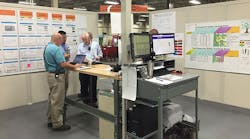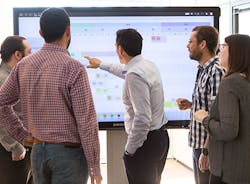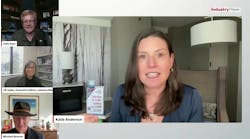If you are a manufacturing organization striving for excellence – and what manufacturing organization isn't – "obeya" is a concept you may want to add to your repertoire. Analogies have been drawn between an obeya and the bridge of a ship, or a war room and even a brain, but the straightforward definition is much simpler. Strictly speaking, "obeya" – sometimes spelled oobeya – is a Japanese word that simply means "big room." In practice, it's much more.
Obeyas provide dedicated space as well as time for coordination and problem-solving, and are designed to minimize organizational barriers, explains Sam MacPherson, executive director of the Lean Leadership Academy. Visual management is a key, with obeya walls typically plastered with charts, tables, and other data or communications for team members to review and act upon. Moreover, he adds, an obeya is a collaborative environment. The end result: quicker, more effective solutions.
"If you think of TPS [Toyota Production System] as being a nervous system, then 'obeya' is actually the brain of the system," describes MacPherson. "It is where that information comes to be synthesized, and digested, and then analyzed, prioritized and decisions made about what are we going to do with this information."
Manufacturing companies like Timken, Toyota, Volvo Group and others employ obeyas as valuable contributors to their lean enterprises.
What an Obeya is Not
An obeya is not a process island. Simply putting all of your engineers in a single, big room does not an obeya make, MacPherson says. Is there collaboration? Are there visual management tools? It matters.
By the same token, a glass-walled room studded with monitors displaying and rotating real-time data every 30 seconds also doesn't qualify as an obeya if it isn't used routinely to collaborate and manage the business. While the room may be visually eye-catching, that may be all it is.
On the other hand, there's the Timken Shiloh plant in Rutherfordton, N.C. Smack in the middle of that facility is an operations obeya, although Timken calls it the operations center or command center. Converted from a training room, the central location means that anyone who needs to be there can reach it in three to five minutes.
Timken's Shiloh plant has been engaged in a lean transformation for about six years, an initiative spurred by a business need to meet sudden growth in its super precision products. The obeya is a piece of that larger lean implementation, and it has been used at the site for more than four years. The Timken Honea Path plant in South Carolina launched the obeya concept earlier this year, and both facilities have received training from MacPherson's Lean Leadership Academy.
When Shiloh operations manager Robert Porter discusses obeya, he's quick to emphasize that first engaging the leadership, from the top to the team leaders, in learning, understanding and embracing lean principles was critical to the success of any specific efforts that followed.
The objective – or prime directive – of Shiloh's obeya is straightforward: Meet today's production requirements today. Cross-functional leaders meet three times daily in the obeya on a schedule to review how the plant is doing and to initiate countermeasures if things go awry. The meetings are short, Porter says, and consume perhaps 45 minutes of the day in total.
A few important points:
- As mentioned previously, obeyas are the ultimate in visual management. At Shiloh, data is delivered to the command center in a chain-of-custody fashion. Production operators log required data in their zone; that data is validated by the team leader. The group leader then is responsible for checking the team leader's thinking and logging the data in the obeya. Porter says the system creates synergy and "forces the engagement on an hourly basis ... the team leader is touching the operator, the group leader is touching the team leader, and there's a matter of checks and balances. But it's also coaching, thinking, helping to drive problem solving."
- Porter takes a critical point gemba walk every day. His first stop is the command center. "I can quickly -- very quickly -- determine if I'm on schedule everywhere or, if I'm not on schedule, where am I not on schedule and why am I not on schedule," he says. Stop two is any place there is a deviation.
- While decision-making, guidance and "check your thinking" activities occur in the obeya, Porter says the goal is to keep the problem-solving efforts at the point of occurrence, meaning at the gemba.
How well has a holistic lean implementation served Timken Shiloh? Well enough that productivity improves year over year, even in down years. Well enough that Timken's Honea Path plant is pursuing a similar course. "What we saw at Shiloh is they had rigorous management, leadership and cadence around processes that delivered results, and so obviously we wanted that to be the case for us," says Randy Dunn, plant manager at the Honea Path Timken manufacturing site.
Toyota's Adrenaline Room
Not surprisingly, obeya is a Toyota staple. At Toyota Industrial Equipment Manufacturing, the obeya methodology aims to get everyone going "in the same direction, rowing together, without walls or silos," says Scott Redelman, TIEM senior manager, production control and logistics. The action, however, takes place in the Adrenaline Room.
"We call it the Adrenaline Room because we are trying to encourage our managers to address the day, every day, urgently, to improve the output to our customers, internal and external. So if we think about each process or each person--even within our four walls--as the customer, how do we aggressively have the adrenaline and the energy, the sense of urgency to quickly react and grow together to make that improvement for the customer," Redelman says. "We have to have the adrenaline to do it."
Following that same theme, daily meetings in the Adrenaline Room are not about rehashing everything that happened the previous day—they are about hitting the highlights of the wins and losses, reviewing any missed targets and outlining measures that will be taken to move the organization closer to its goals.
The meetings also are not about presenting to the executive team, although its members are in attendance--along with managers and subject matter experts. That can be a challenge as the natural inclination is to address the boss.
"What we try to do is let the management team at the manager level lead the meeting," Redelman says. "We want to encourage direct dialog between the managers so they take ownership of the condition." The meeting is most effective, he adds, "when the managers and SMEs are gathered, speaking to each other, and the executive team has faded to the back and just offers suggestion when necessary or helps to prioritize the focus to wrap up the meeting."
Discussions about lean and obeya frequently emphasize the human element, the need for individuals to physically interact with the data to take full advantage of an obeya's promise. It's a point Toyota emphasizes as well.
"All the ways that we report are typically quite manual, and that's intentional," Redelman says. "We have a lot of graphs, bar charts, line graphs, that are filled in manually in the room so that we build the culture ... the managers understand the data they are putting on the wall and reflect on where the gaps are and where we can possibly improve. During the meeting, there are a lot of times when somebody will handwrite on somebody else's chart ... or scratch an idea out or open some discussion--so it's not a reporting meeting, per se, it's truly a change the daily operations with adrenaline process."
Obeya Gets Digital
That said, in many instances manufacturing production teams are located in a single site. But what if team members are globally dispersed, such as global product development teams or sales organizations? A manual approach is much more difficult. How does one effectively employ an obeya then? The answer: They get digital.
Consider the challenge Volvo Group encountered in 2010. While the manufacturer of trucks and buses has implemented lean across its factory operations for decades, it began implementing lean across product development and support functions such as information technology in 2008. In 2010 the organization began rolling out the obeya concept across those same functions.
"Our first challenge was the need to run lean practices, use sticky notes … on teams [that] can be spread over the globe," explains Volvo's Christophe Chauffrut, who leads visual performance management across product development and support functions. "Volvo is located over five continents, and we need teams to collaborate."
iObeya offers a digital solution for globally dispersed teams.
That challenge was but one trigger that led Volvo Group to consider a digital solution. "One other trigger was the lack of dedicated physical room to support all our projects. We needed a way to consolidate and host several projects in the same premises," Chauffrut said. Additionally, the company saw an opportunity to reduce travel expenses during what was a downturn in the economy.
France's PSA Group (formerly PSA Peugeot Citroën) faced several similar challenges when, in 2007, the multinational automaker began to expand its lean system from the manufacturing floor to other areas of the enterprise. It embraced the obeya process but ran up against several constraints.
Both manufacturers are meeting their global collaboration challenge with the aid of iObeya, a digital visual management platform that, when used in conjunction with large, interactive touchscreen displays, mimics the paper-based stand-up meetings that are typical activities within an obeya. Moreover, PSA played a role in the development of iObeya, says Zal Pezhman, vice president, general manager at iObeya.
The automaker in 2009 approached software and services provider Kap IT and outlined its challenge in taking lean to globally dispersed teams. The two companies then co-conceived version 1 of iObeya, and PSA consequently became iObeya's first customer that "validated iObeya for lean and for large-scale industrial deployment," Pezhman says.
The automaker now has more than 10,000 users in 31 countries employing iObeya across many functions, including research and development, engineering, IT, human resources and more, he added.
The iObeya solution provider acknowledges that classic obeya thinking promotes a limit to the use of technology because the goal is to actively engage participants. That said, Pezhman describes iObeya as "human-centric." "It requires human interaction to make it work," he says, and it doesn't deter companies from employing the rituals they have worked on diligently to develop a lean culture. The platform "should and does mold itself to existing methodologies."
The Volvo Group largely appears to agree. Approximately 700 teams within the company are using iObeya, and Chauffrut says the digital solution allows users to pursue the "spirit" of lean, just within an electronic landscape.
"The challenge is not the tool," Chauffrut says. The challenge is the lean implementation, he explains -- training the workforce so they understand lean principles, developing a culture that is open to change and problem-solving.
Those are what is most important, he says, "not the tool."






